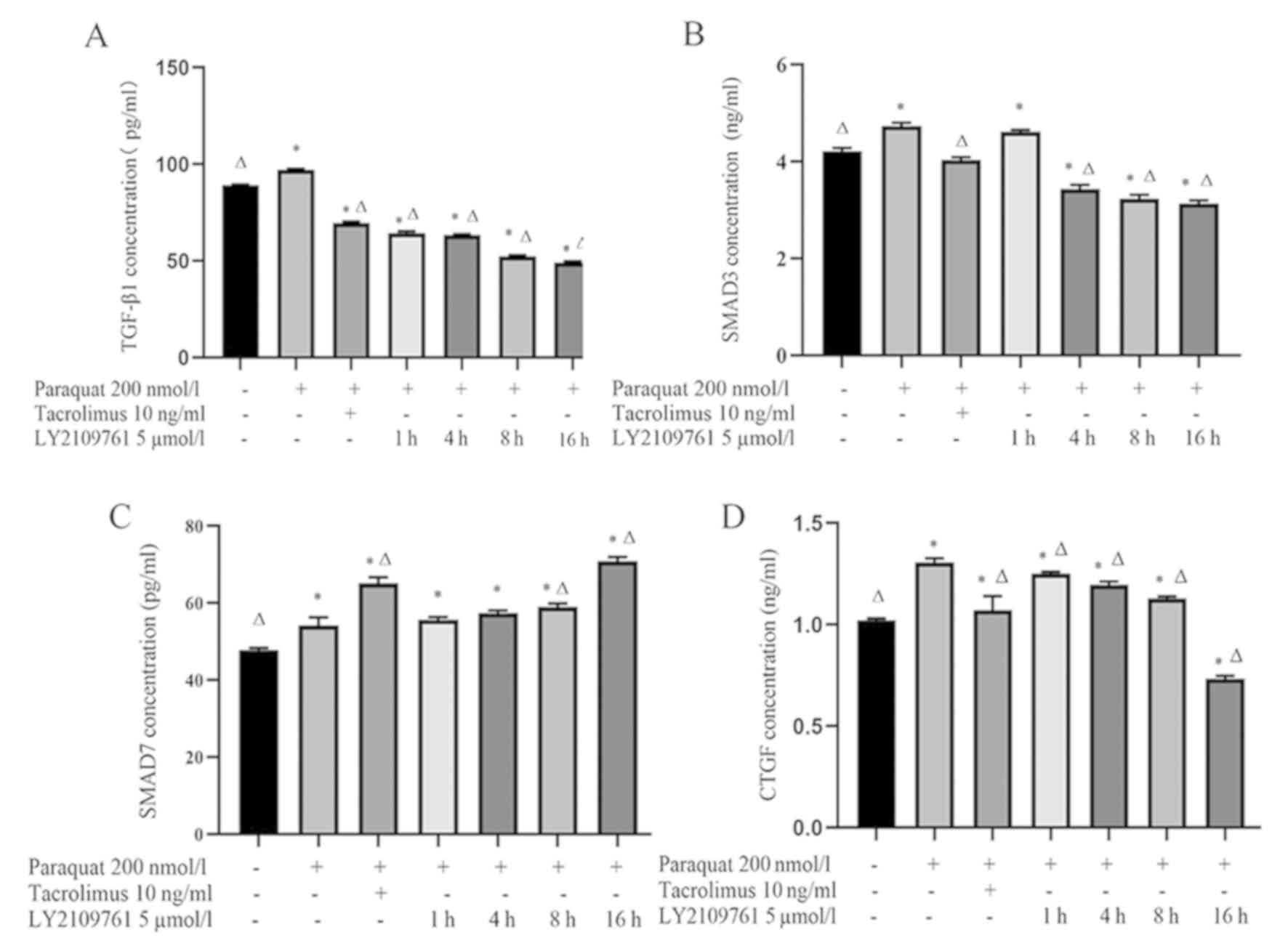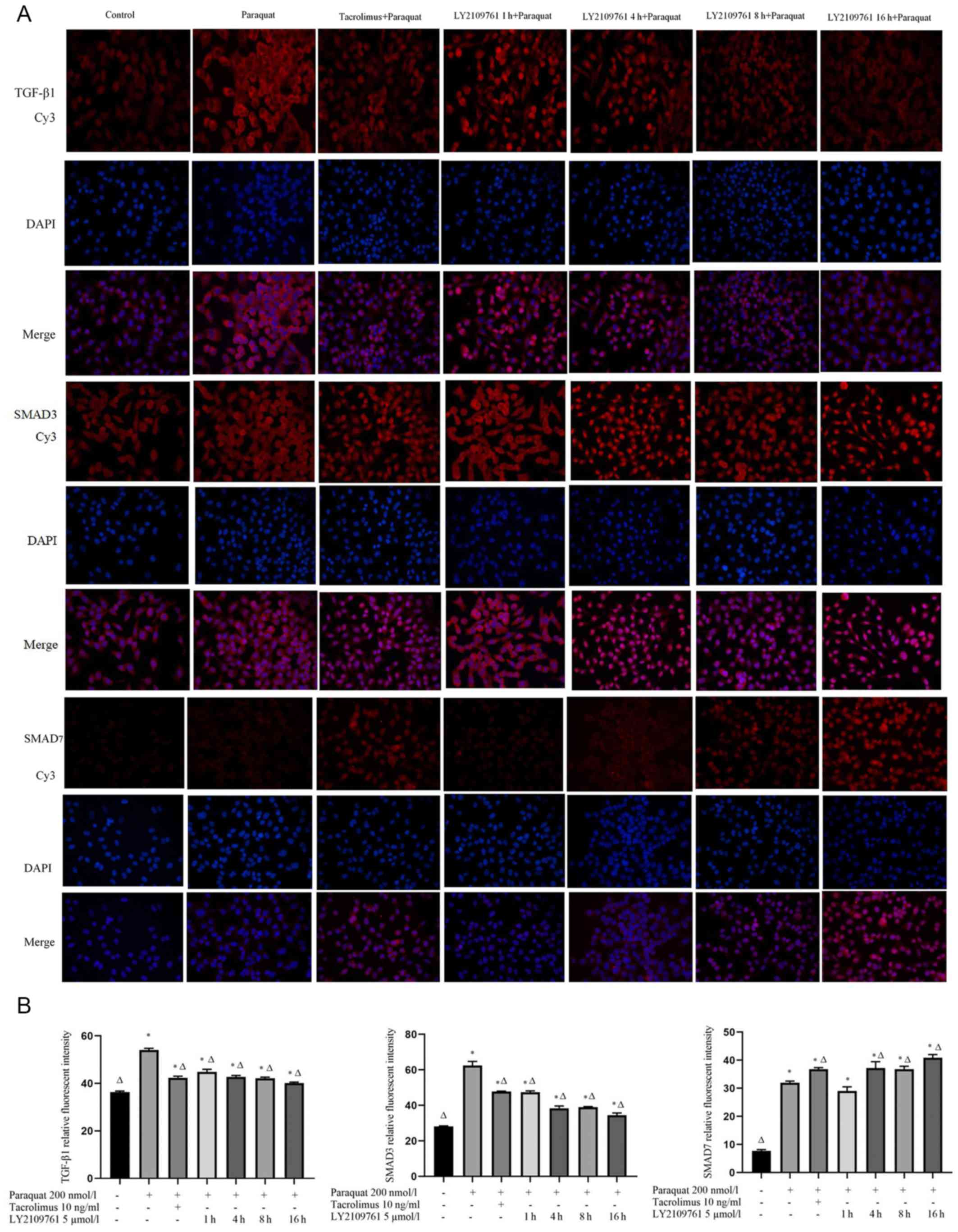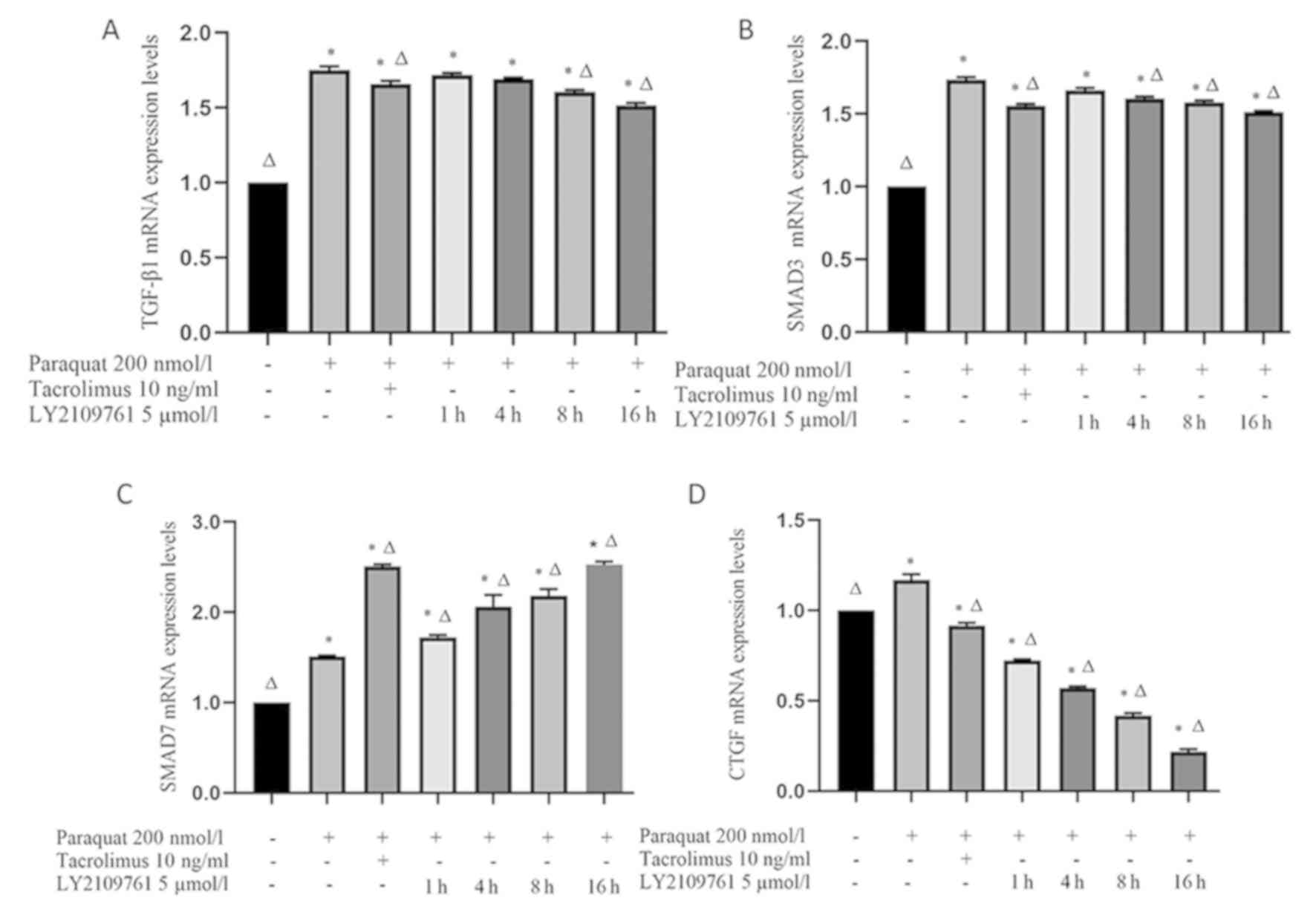|
1
|
Dinis-Oliveira RJ, Duarte JA,
Sánchez-Navarro A, Remião F, Bastos ML and Carvalho F: Paraquat
poisonings: Mechanisms of lung toxicity, clinical features, and
treatment. Crit Rev Toxicol. 38:13–71. 2008. View Article : Google Scholar : PubMed/NCBI
|
|
2
|
Jeyaratnam J: Acute pesticide poisoning: A
major global health problem. World Health Stat Q. 43:139–144.
1990.PubMed/NCBI
|
|
3
|
Gil HW, Hong JR, Jang SH and Hong SY:
Diagnostic and therapeutic approach for acute paraquat
intoxication. J Korean Med Sci. 29:1441–1449. 2014. View Article : Google Scholar : PubMed/NCBI
|
|
4
|
Yamashita M, Yamashita M and Ando Y: A
long-term follow-up of lung function in survivors of paraquat
poisoning. Hum Exp Toxicol. 19:99–103. 2000. View Article : Google Scholar : PubMed/NCBI
|
|
5
|
He X, Wang L, Szklarz G, Bi Y and Ma Q:
Resveratrol inhibits paraquat-induced oxidative stress and
fibrogenic response by activating the nuclear factor erythroid
2-related factor 2 pathway. J Pharmacol Exp Ther. 342:81–90. 2012.
View Article : Google Scholar : PubMed/NCBI
|
|
6
|
Eddleston M, Wilks MF and Buckley NA:
Prospects for treatment of paraquat-induced lung fibrosis with
immunosuppressive drugs and the need for better prediction of
outcome: A systematic review. QJM. 96:809–824. 2003. View Article : Google Scholar : PubMed/NCBI
|
|
7
|
Qian J, Ye Y, Lv L, Zhu C and Ye S: FTY720
attenuates paraquat-induced lung injury in mice. Int
Immunopharmacol. 21:426–431. 2014. View Article : Google Scholar : PubMed/NCBI
|
|
8
|
Botella DMJ and Belenguer TJ: Paraquat
poisoning. A study of 29 cases and evaluation of the effectiveness
of the ‘Caribbean scheme’. Med Clin (Barc). 115:530–533.
2000.PubMed/NCBI
|
|
9
|
Gao J, Feng S and Li Y: Prolonged low-dose
cyclophosphamide treatment after pulse therapy attenuates lung
injury in rats with paraquat intoxication. Korean J Intern Med.
33:1137–1142. 2018. View Article : Google Scholar : PubMed/NCBI
|
|
10
|
Barnes H, Holland AE, Westall GP, Goh NSL
and Glaspole IN: Cyclophosphamide for connective tissue
disease-associated interstitial lung disease. Cochrane Database Sys
Rev. 1:CD0109082018.
|
|
11
|
Thomson AW and Starzl TE: New
immunosuppressive drugs: Mechanistic insights and potential
therapeutic advances. Immunol Rev. 136:71–98. 1993. View Article : Google Scholar : PubMed/NCBI
|
|
12
|
Artz MA, Boots JMM, Ligtenberg G, Roodnat
JI, Christiaans MHL, Vos PF, Blom HJ, Sweep FCG, Demacker PNM and
Hilbrands LB: Improved cardiovascular risk profile and renal
function in renal transplant patients after randomized conversion
from cyclosporine to tacrolimus. J Am Soc Nephrol. 14:1880–1888.
2003. View Article : Google Scholar : PubMed/NCBI
|
|
13
|
O'Grady JG, Hardy P, Burroughs AK and
Elbourne D; UK; Ireland Liver Transplant Study Group, : Randomized
controlled trial of tacrolimus versus microemulsified cyclosporin
(TMC) in liver transplantation: Poststudy surveillance to 3 years.
Am J Transplant. 7:137–141. 2007. View Article : Google Scholar : PubMed/NCBI
|
|
14
|
Kim YH, Shin HY and Kim SM: Long-term
safety and efficacy of tacrolimus in myasthenia gravis. Yonsei Med
J. 60:633–639. 2019. View Article : Google Scholar : PubMed/NCBI
|
|
15
|
Nagano J, Iyonaga K, Kawamura K, Yamashita
A, Ichiyasu H, Okamoto T, Suga M, Sasaki Y and Kohrogi H: Use of
tacrolimus, a potent antifibrotic agent, in bleomycin-induced lung
fibrosis. Eur Respir J. 27:460–469. 2006. View Article : Google Scholar : PubMed/NCBI
|
|
16
|
Staab-Weijnitz CA, Fernandez IE, Knüppel
L, Maul J, Heinzelmann K, Juan-Guardela BM, Hennen E, Preissler G,
Winter H, Neurohr C, et al: FK506-binding protein 10, a potential
novel drug target for idiopathic pulmonary fibrosis. Am J Resp Crit
Care. 192:455–467. 2015. View Article : Google Scholar
|
|
17
|
Dhainaut JF, Charpentier J and Chiche JD:
Transforming growth factor-beta: A mediator of cell regulation in
acute respiratory distress syndrome. Crit Care Med. 31 (Suppl
4):S258–S264. 2003. View Article : Google Scholar : PubMed/NCBI
|
|
18
|
Bartram U and Speer CP: The role of
transforming growth factor beta in lung development and disease.
Chest. 125:754–765. 2004. View Article : Google Scholar : PubMed/NCBI
|
|
19
|
Livak KJ and Schmittgen TD: Analysis of
relative gene expression data using real-time quantitative PCR and
the 2(-Delta Delta C(T)) method. Methods. 25:402–408. 2001.
View Article : Google Scholar : PubMed/NCBI
|
|
20
|
Sukumar CA, Shanbhag V and Shastry AB:
Paraquat: The poison potion. Indian J Crit Care Med. 23 (Suppl
4):S263–S266. 2019.PubMed/NCBI
|
|
21
|
Hoet PH, Lewis CP, Demedts M and Nemery B:
Putrescine and paraquat uptake in human lung slices and isolated
type II pneumocytes. Biochem Pharmacol. 48:517–524. 1994.
View Article : Google Scholar : PubMed/NCBI
|
|
22
|
Willis BC and Borok Z: TGF-beta-induced
EMT: Mechanisms and implications for fibrotic lung disease. Am J
Physiol Lung Cell Mol Physiol. 293:L525–L534. 2007. View Article : Google Scholar : PubMed/NCBI
|
|
23
|
Kim KK, Kugler MC, Wolters PJ, Robillard
L, Galvez MG, Brumwell AN, Sheppard D and Chapman HA: Alveolar
epithelial cell mesenchymal transition develops in vivo during
pulmonary fibrosis and is regulated by the extracellular matrix.
Proc Natl Acad Sci USA. 103:13180–13185. 2006. View Article : Google Scholar : PubMed/NCBI
|
|
24
|
Blank U and Karlsson S: The role of Smad
signaling in hematopoiesis and translational hematology. Leukemia.
25:1379–1388. 2011. View Article : Google Scholar : PubMed/NCBI
|
|
25
|
Chung AC, Zhang H, Kong YZ, Tan JJ, Huang
XR, Kopp JB and Lan HY: Advanced glycation end-products induce
tubular CTGF via TGF-beta-independent Smad3 signaling. J Am Soc
Nephrol. 21:249–260. 2010. View Article : Google Scholar : PubMed/NCBI
|
|
26
|
Chen QK, Lee K, Radisky DC and Nelson CM:
Extracellular matrix proteins regulate epithelial-mesenchymal
transition in mammary epithelial cells. Differentiation.
86:126–132. 2013. View Article : Google Scholar : PubMed/NCBI
|
|
27
|
Krafft E, Lybaert P, Roels E, Laurila HP,
Rajamaki MM, Farnir F, Myllarniemi M, Day MJ, Mc EK and Clercx C:
Transforming growth factor beta 1 activation, storage, and
signaling pathways in idiopathic pulmonary fibrosis in dogs. J Vet
Intern Med. 28:1666–1675. 2014. View Article : Google Scholar : PubMed/NCBI
|
|
28
|
Nie Y, Li S, Yi Y, Su W, Chai X, Jia D and
Wang Q: Effects of astragalus injection on the TGFβ/Smad pathway in
the kidney in type 2 diabetic mice. BMC Complement Altern Med.
14:1482014. View Article : Google Scholar : PubMed/NCBI
|


















